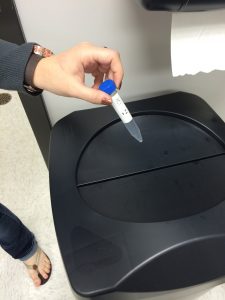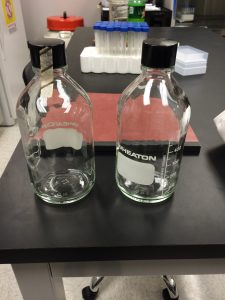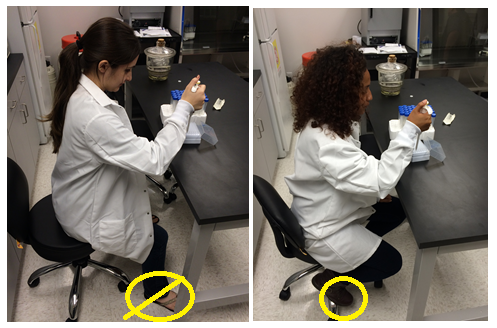10 Things NOT to Do in a Research Lab

Most of the following items should be common sense. But you’d be surprised on how often I see these simple mistakes occur. If you ever have to work in a research lab, take note of this list—your co-workers and your body will thank you for it!
1. Wearing open-toed shoes
It is important to wear closed toed shoes in the lab for a variety of reasons. If you drop something, such as glassware or chemicals, your feet will be safe and sound.
2. Keeping long hair down
Long hair can be beautiful, but if it’s not tied back properly in a research lab, it can be a huge problem! Long hair can easily get in the way of a chemical solution or open flame. It can even contaminate something you are trying to keep sterile. Trust me, none of this makes for a happy ending.
3. Eating or drinking
Eating and drinking in the reserch lab is a very bad idea. Not only can you contaminate your food with chemicals, but you can also contaminate your samples with your lunch or snack. No one wants to start an experiment over because of silly contamination that can easily be avoided. Just don’t do it!

4. Erasing data from your notebook
Never erase, white-out or scratch out data or notes from your lab notebook. Your notebook is a permanent, primary, documented record of your experimental observations within the lab. If you “mess up,” simply draw a single line through the error, but leave it visible and legible so someone reading your notes can understand what was written previously without explanation.
5. Showing up late
Timing is very important in a research lab. If you show up late or take too long for a lunch break, you could miss the proper window for a time critical step in your assay or experiment, potentially wasting valuable materials and preparation time. A lot of experiments fall into the category of “hurry up and wait,” but it’s important to be on the ball once your timer goes off and you need to add the next reagent or take your sample out of the water bath.
6. Forgetting to label samples or materials
This one may really seem like a no-brainer, especially if you are making a working solution of a chemical that you will be using long term. However, when completing a simple experiment with one or two test tubes, many people take the easy route and don’t label their tubes. In that type of experiment, it would be easy to keep track of your tubes, but not labeling your samples or materials is a very BAD habit to get into. You don’t want to have 96 tubes corresponding to 96 samples and realize halfway through that you might have switched two tubes.

7. Incorrectly disposing of your materials
Many people have different opinions on how to dispose of various waste. It is important to adhere to your departmental guidelines for waste disposal, as the penalties for ignoring these guidelines (if you’re caught) are not pleasant. Be sure to keep both regular trash cans, bio hazard waste containers, liquid and solid hazardous waste containers handy so you aren’t tempted to throw something in the closest waste basket.
8. Wearing shorts
For safety purposes, always wear long pants in the research lab. As with wearing open toed shoes, more exposed skin creates a bigger safety concern when working with dangerous chemicals and materials.
9. Using the wrong materials
Pay close attention when you need to use special materials for an experiment. Let’s say you need to use all sterile materials for an assay. Glassware is a common piece of equipment in the lab that is reused frequently. It can be hand washed to clean it or autoclaved to sterilize it. If your experiment calls for sterility, you want to make sure you use sterilized glassware (as shown by the activated autoclave tape on the bottle on the left of the picture) for preparing your materials as opposed to just clean (handwashed) glassware (as shown on the right).

10. Not wearing gloves when sterility is needed
Gloves are an integral part of lab safety. They are also extremely helpful in preventing contamination. Not all gloves come sterile, but in conjunction with good sterile technique, they are critical for any experiments where contamination could be a huge problem.
%CODE1CHEMICALENGINEERING%





